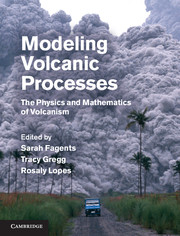Book contents
- Frontmatter
- Contents
- Contributors
- Chapter 1 Introduction
- Chapter 2 Magma chamber dynamics and thermodynamics
- Chapter 3 The dynamics of dike propagation
- Chapter 4 Dynamics of magma ascent in the volcanic conduit
- Chapter 5 Lava flows
- Chapter 6 Unsteady explosive activity
- Chapter 7 Unsteady explosive activity
- Chapter 8 Sustained explosive activity
- Chapter 9 Modeling tephra sedimentation from volcanic plumes
- Chapter 10 Pyroclastic density currents
- Chapter 11 Magma–water interactions
- Chapter 12 Deep-sea eruptions
- Chapter 13 Volcano–ice interactions
- Chapter 14 Modeling lahar behavior and hazards
- Chapter 15 Introduction to quantitative volcano seismology
- Chapter 16 Volcano acoustics
- Chapter 17 Planetary volcanism
- Index
- Plate section
- References
Chapter 16 - Volcano acoustics
Published online by Cambridge University Press: 05 March 2013
- Frontmatter
- Contents
- Contributors
- Chapter 1 Introduction
- Chapter 2 Magma chamber dynamics and thermodynamics
- Chapter 3 The dynamics of dike propagation
- Chapter 4 Dynamics of magma ascent in the volcanic conduit
- Chapter 5 Lava flows
- Chapter 6 Unsteady explosive activity
- Chapter 7 Unsteady explosive activity
- Chapter 8 Sustained explosive activity
- Chapter 9 Modeling tephra sedimentation from volcanic plumes
- Chapter 10 Pyroclastic density currents
- Chapter 11 Magma–water interactions
- Chapter 12 Deep-sea eruptions
- Chapter 13 Volcano–ice interactions
- Chapter 14 Modeling lahar behavior and hazards
- Chapter 15 Introduction to quantitative volcano seismology
- Chapter 16 Volcano acoustics
- Chapter 17 Planetary volcanism
- Index
- Plate section
- References
Summary
Overture
Acoustic waves are pressure fluctuations induced by unsteady fluid motions, and can be generated in volcanoes by diverse processes ranging from the discrete impact of a rockfall, to the harmonious reverberation of a lava tube; through the impulsive punctuations of strombolian and vulcanian explosions, and culminating with roaring jet noise from subplinian and plinian eruptions. This chapter highlights the range of volcano-acoustic source processes associated with eruptive activity ranging from hawaiian to plinian. It introduces various ways to induce magma−gas mixtures into explosive releases, aperiodic fluctuations, and harmonic oscillations. We begin by introducing some fundamental concepts in acoustics and then outline the methods used to extract useful information from complex and diverse volcanic soundscapes.
Exposition
The science of acoustics specializes in the recording, analysis, and interpretation of sound, which in the Earth’s atmosphere is caused by waves of compressed and rarefied air. The reference root mean square pressure for airborne sound is 20 μPa (20 × 10–6 Pa), which corresponds to the faint buzzing of a mosquito 3 meters away and is near the lower threshold of human hearing. In contrast, large eruptions may produce peak overpressures in excess of 100 Pa at a distance of a few kilometers. Volcanoes tend to produce sound with low frequencies (f), or long periods (period T is the reciprocal of frequency, T = 1/f; all notation is listed in Section 16.8). Humans can hear sound within the frequency range of 20−20 000 cycles per second or hertz (Hz). Above 20 000 Hz lies ultrasound, which bats famously exploit for echolocation, whereas infrasound is below 20 Hz. In the infrasound range we lose our perception of tonality, or pitch, so that even a pure tone would be perceived as a percussive beat with a tempo equal to the tone frequency (2 Hz = 120 beats per minute; Leventhall et al., 2003).
Information
- Type
- Chapter
- Information
- Modeling Volcanic ProcessesThe Physics and Mathematics of Volcanism, pp. 359 - 383Publisher: Cambridge University PressPrint publication year: 2013
References
Accessibility standard: Unknown
Why this information is here
This section outlines the accessibility features of this content - including support for screen readers, full keyboard navigation and high-contrast display options. This may not be relevant for you.Accessibility Information
- 18
- Cited by
